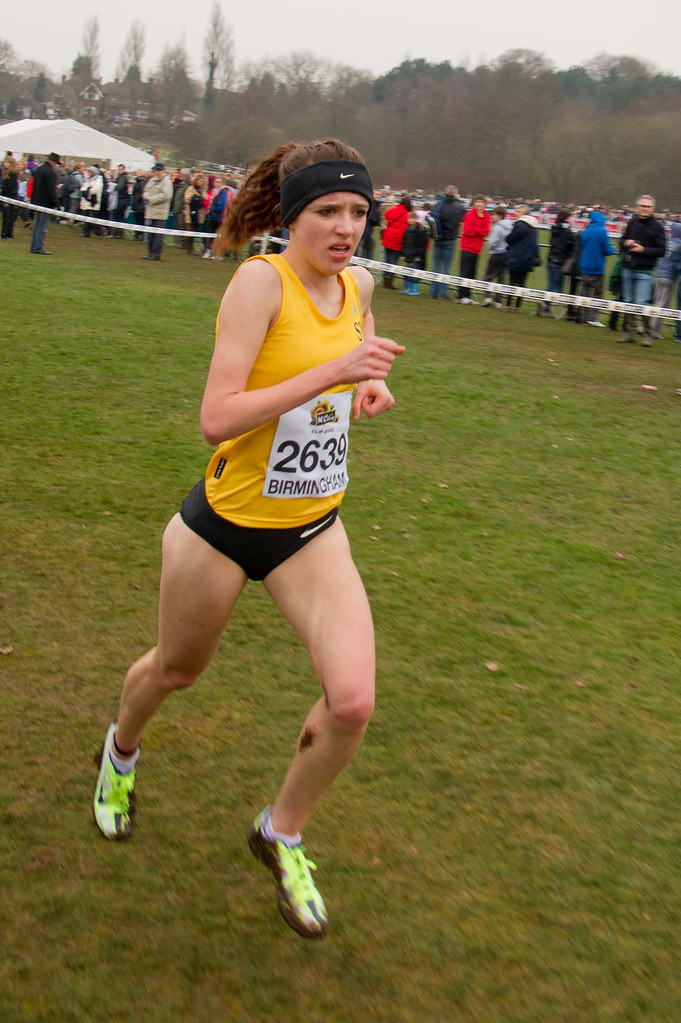 |
| Fionnuala Britton leads Gemma Steel in muddy Antrim Photo: Mark Shearman http://www.iaaf.org/Mini/CROS12/News/NewsDetail.aspx?id=63390 |
Thumbs up, if you missed watching the World Cross Country championships last week end. Thumbs down for all the people who made possible that disappointing decision of changing the oldest annual international track and field event in biannual. Until this year only World Wars had stopped a race which had been held since 1903 but I guess we will have to get used to it. Once an Olympic event, once the most prestigious race in the yearly athletic calendar, which used to join every world class runner from the 1500m to the marathon, nowadays it seems to be in plain decadence. This winter we were supposed to focus in area championships. It was amazing after all to watch the bunch of Ethiopian-born athletes who have become Bahrain Kenya, Seville Spain
For a small island of scarcely 4 millions,  |
| Fionnuala Britton competing at the 3000m steeplechase final at the 2007 World Championships in Osaka Photo: Michael Steele/ Getty Images Sport http://www.zimbio.com |
Since the great Sonia O’Sullivan’s decline, Irish press has been talking about national crisis in track and field. However it is not really fair. No more Olympic medals were achieved and the same O’Sullivan and Eamonn Coghlan remain the only world champions for the shamrock country but David Gillick grabbed gold at the 2005 and 2007 European indoor champs at the 400m, Derval O’Rourke accomplished another marvellous victory at the hurdles at the 2006 World indoors in Moscow and race walkers Gillian O’Sullivan and Olive Loughnane struck silver at the summer world champs in Saint Dennis 2003 and Berlin 2009 respectively, besides other minor medals. However, only victories seem to make an impact in an Irish public more devoted to hurling, soccer and rugby. (1) Silver medals and minor victories in track and field pass almost unnoticed. When Gillian O’Sullivan success I was living in Galway . In the West Coast, and I suppose in the rest of the country, is quite popular among men and women a very fast stroll by the seaside. I never experienced in Spain or France
Equally unnoticed has been until her victory at the European Cross Fionnuala Britton, who had participated in nine occasions with solid results and also in Beijing Olympics at the steeplechase. However, thereafter the tiny athlete has become suddenly popular and the audience is asking for more. “I just think it is really weird. You are doing what you always did and then suddenly you win a race and then people are interested in it. It is not really any different in what you are doing. I think the biggest thing is that all the sports are not looked at in the same light. The soccer team, I know it is great that they qualified for Europeans and I know that it is a really big deal — but it is Europeans. In minority sports, unless you do something really big, you are not looked at. And then if you do something, you are expected to do something again. The expectations and the coverage are not the same. It is the same with women’s sport. It is not big until you do something really big, and then you are expected to keep doing it like poor Katie Taylor.” (2) And now Fionnuala can become as big in County Wicklow
Fionnuala Britton, who will be 28 years old the next 24th September, is a native of Kilcoole, just a couple of miles of Brittas Bay one of the most popular and scenic places of County Wicklow, which 4km of sandy dunes are home of rare vegetal and animal species, notably birds. Fionnuala grew up in a close-knit family of six members, amateur of sport. As an example the whole family ran last Great Ireland Run in Phoenix Park Dublin City University
 |
| Fionnuala Britton is honoured at the Sports Woman of the Year at the Shelbourne Hotel in Dublin Photo: WENN.com http://entertainment.ie |
As a junior, Fionnuala had limited success. Her first international medal would be accomplished no sooner than the winter of 2006 at the European Cross championships U-23, where she placed second after Turkish Binnaz Uslu. It was a huge boost of confidence and the 2007 season would be excellent for the young Irish. After beating at the national senior Inter Club Cross Country Champs the more fancied Mary Cullen at her rival’s hometown of Sligo, the Kilcoole girl headed for the World Cross in Mombasa Beijing
Much was expected from Fionnuala Britton alter her excellent 2007 campaign. However her post-Beijing Olympic years were rather disappointing. The Slí Chúlainn athlete did not make the standard for Berlin Worlds and finished in a poor 11th place inBarcelona Dublin
Much was expected from Fionnuala Britton alter her excellent 2007 campaign. However her post-Beijing Olympic years were rather disappointing. The Slí Chúlainn athlete did not make the standard for Berlin Worlds and finished in a poor 11th place in
 |
| Fionnuala Britton leads Sarah Treacy, Ciara Mageean and other hopeful local girls http://lindienaughton.blogspot.com.es/2011/12/on-your-marks-from-herald-dec-3.html |
Fionnuala went in November to Font Romeu for training
in altitude in order to prepare the European Cross champs. The precedent
edition of the contest had had a shocking ending for the Irish athlete. Running
at home in Albufeira, Jessica Augusto produced an unrivalled solo performance. After
a noteworthy race, Fionnuala was in contention for the silver medal but she was
defeated in the last rush, again by Uslu and also second Portuguese Dulce Felix
by a whisker. Besides she had beaten soon afterwards those rivals in Brussels Edinburgh
Currently, Fionnuala Britton is concentrated in Albuquerque London London
 |
| European XC champion Fionnuala Britton and children get fit for the 2012 Great Ireland Run http://www.athleticsireland.ie/content/?p=22729 |
(6) http://www.independent.ie/sport/other-sports/athletics-gold-run-goes-according-to-plan-2967043.html




